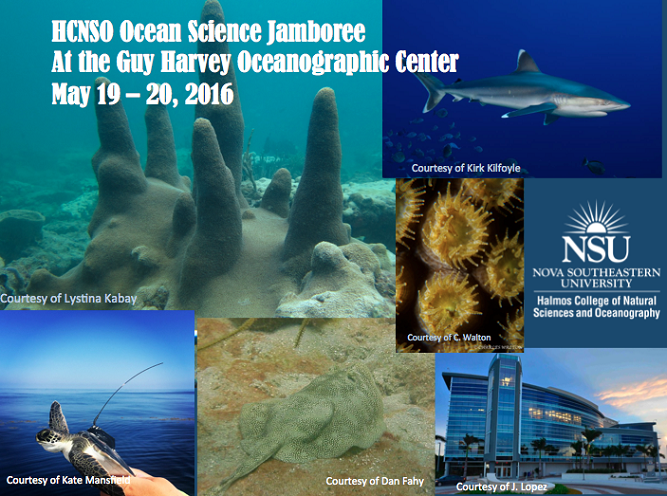What Arabian coral reefs can teach us about the past, the future, and the management of the word’s coral reefs
Location
Guy Harvey Oceanographic Center Facility
Start
5-20-2016 5:45 PM
End
5-20-2016 6:00 PM
Abstract
Arabian coral reefs are a window into the past and the future. Absence of well-developed frameworks in the southern Gulf indicate a long-term stressful, historical environmental regime. This contrasts with the northern Gulf, where better environmental conditions allowed reefs to progress further in geological succession. Since the late 1990s, thermal bleaching of corals has occurred with the highest frequency observed anywhere in the world. The Gulf now has a thermal regime that is predicted to occur across the tropical oceans in 2100 and studies of Gulf reefs today allow us to draw inferences on future pathways of stress and changes in coral assemblages across the world. Gulf coral communities are made up by three major groups of competitors (Acropora-merulinids-poritids) that converge upon a stable equilibrium, where they co-exist but Acropora dominates. Less tolerance to temperature and greater susceptibility to diseases makes Acropora vulnerable to dieback in extreme years, which allows slower-growing massive corals (faviids, poritids) to persist and even expand. Over the past two decades, dieback episodes occurred five times as frequently as in the early 20th century, causing significant changes in coral communities. Acropora death and availability as settlement substratum changes a competitive network from stable into unstable. But during very frequent and severe annually recurring disturbances, also poritids and merulinids die back, and now can positively influence populations via settling space on denuded colonies, therefore the competitive network is unstable. Trajectories are hard to predict and depend on local fertility or connectivity. Therefore, Gulf coral communities are not arranged orderly along environmental gradients, but are patchy and variable. Global change will continue to cause mortality and stability of competitive networks in many other regions will be degraded with hardly predictable outcomes. Lessons for the management of Gulf coral reefs, however, are clear:
- no species must be lost. Otherwise trajectories of even the best-managed reefs will be unpredictable.
- Threatened Acropora should be given special protection to safeguard remaining populations.
- Maximum connectivity must be maintained between different reef regions, to allow recolonization of degraded reefs.
- Networks of large marine protected areas are required
- Impacts in the coastal zone must be reduced since coral larvae must traverse also reef-free zones.
What Arabian coral reefs can teach us about the past, the future, and the management of the word’s coral reefs
Guy Harvey Oceanographic Center Facility
Arabian coral reefs are a window into the past and the future. Absence of well-developed frameworks in the southern Gulf indicate a long-term stressful, historical environmental regime. This contrasts with the northern Gulf, where better environmental conditions allowed reefs to progress further in geological succession. Since the late 1990s, thermal bleaching of corals has occurred with the highest frequency observed anywhere in the world. The Gulf now has a thermal regime that is predicted to occur across the tropical oceans in 2100 and studies of Gulf reefs today allow us to draw inferences on future pathways of stress and changes in coral assemblages across the world. Gulf coral communities are made up by three major groups of competitors (Acropora-merulinids-poritids) that converge upon a stable equilibrium, where they co-exist but Acropora dominates. Less tolerance to temperature and greater susceptibility to diseases makes Acropora vulnerable to dieback in extreme years, which allows slower-growing massive corals (faviids, poritids) to persist and even expand. Over the past two decades, dieback episodes occurred five times as frequently as in the early 20th century, causing significant changes in coral communities. Acropora death and availability as settlement substratum changes a competitive network from stable into unstable. But during very frequent and severe annually recurring disturbances, also poritids and merulinids die back, and now can positively influence populations via settling space on denuded colonies, therefore the competitive network is unstable. Trajectories are hard to predict and depend on local fertility or connectivity. Therefore, Gulf coral communities are not arranged orderly along environmental gradients, but are patchy and variable. Global change will continue to cause mortality and stability of competitive networks in many other regions will be degraded with hardly predictable outcomes. Lessons for the management of Gulf coral reefs, however, are clear:
- no species must be lost. Otherwise trajectories of even the best-managed reefs will be unpredictable.
- Threatened Acropora should be given special protection to safeguard remaining populations.
- Maximum connectivity must be maintained between different reef regions, to allow recolonization of degraded reefs.
- Networks of large marine protected areas are required
- Impacts in the coastal zone must be reduced since coral larvae must traverse also reef-free zones.


